Rules for planting and caring for Japanese garden azalea
To plant a Japanese garden azalea to succeed, you need to heed the advice and provide proper care. The reward will be luxurious flower beds or tastefully decorated corners of a shady garden. Growing different types of azaleas creates the effect of a bright cloud floating low above the ground. Or a marvelous oriental carpet thrown casually on the grass.
What varieties are suitable for garden decoration?
Why is azalea attractive? Lush flowering bush, shoots are so densely covered with buds that you cannot see the leaves. And they are good for the plant: dark green, velvety, miniature. In Japan, the cultivation of azalea bushes is practiced to obtain hedges up to two meters high. In our country, several types of shrubs are bred, the sizes vary depending on the varietal affiliation. The flower beds can be decorated with specimens from 25 cm, and meter-long giants can be planted along the garden paths.
Advice! Before purchasing seedlings, it is worth studying the basic rules for breeding. Garden azalea will wither under the scorching sun, and some varieties prefer bright lighting.
If the care of the bushes is carried out at the proper level, then the abundant flowering will not keep you waiting. Some azaleas begin to bud as early as May. Flowering lasts from 1.5 to 3 months before the onset of autumn cold snap. Flowers differ in size and shape - they are small and graceful, large and double. The color of the blossoming buds is varied:
- white with a cream shade;
- lilac;
- purple;
- rich pink;
- bright burgundy.
When buying seedlings, you need to pay attention to the frost resistance of the species. There are those that can only be grown in the south of the country. Fortunately, Japanese azalea was also developed for middle latitudes. This happened thanks to crossing with the northern rhododendron. The resulting plants tolerate even 25-degree frosts, planting and caring for them is not difficult.
Which breeding method should you choose?
An easy way is propagation by cuttings. At an oblique angle, cut the cuttings about 8 cm and remove the bud, as well as unblown leaves. A cut of the cuttings with a couple of leaves are treated with a growth stimulator, and planted in pots. To prevent root decay, it is necessary to make enough drainage holes. The pots are covered with foil and placed in a well-lit place at a temperature of 20-22 ° C.
Advice! The film should not come into contact with the seedling. Part of it will rot, which will spread over the entire surface. For this, one should not forget about daily airing for an hour.
Rooting will take place in one month. The first sign that the Japanese beauty has grown roots and that the seedlings were properly looked after is the formation of new leaves. After another month, the young azalea is ready for planting in flower beds. The soil can be composed of the following components:
- leafy land;
- coniferous land;
- calcined sand;
- peat.
Growers don't often use seed growing. Even rooted cuttings of azalea bloom only in the 2-3rd year, and planting and waiting for adult plants from the seed postpones this process for an even longer period. Some lovers of azaleas in the garden divide the bush into two parts in the fall. With a knife, they cut it in half and coat the cut off points with garden pitch. This method is not popular because of the formation required in the future.
What is required for a successful landing?
If there are conifers, then you do not have to decide on a place for planting azaleas.In the shade of their branches in diffused light, caring for the bushes will be easier. Under the bright sun, the Japanese guest begins to ache - the leaves wrinkle, shoots stop forming. Garden azalea does not like strong gusts of wind and sudden changes in temperature. Growing and caring for seedlings in the open field begins in late spring. The holes should be made shallow (about 45 cm), but wide.
Advice! In order for the plant to bloom well, experts recommend laying a layer of drainage under the flower bed. The top layer of the soil is removed, and broken brick is poured onto the bottom. The main thing is that it does not have the ability to leach the soil.
High-quality plant care is possible only when it grows in soil with a PH value below 4.7. Planting requires acidifying the earth with a food acid solution (a pinch in a bucket of water). For the lush flowering of azaleas in spring, organic fertilizers are applied to the soil. Finishing planting in the open field, mulch the flower bed with the following materials:
- needles or bark of coniferous trees;
- peat;
- oak leaves;
- chopped straw.
Mulching is necessary to preserve moisture in the soil and protect it from possible frost. Despite the fact that caring for an azalea requires abundant watering, the place for the flower bed should not be swampy. Root decay cannot be avoided. The final stage of planting in the garden will be watering the land with settled tap water.
What do you need to know about grooming?
So that the Japanese azalea does not get sick, it is necessary to take proper care of it. The root system of the plant is almost on the surface of the soil, so watering at the root will not work. Moisture should spread throughout the entire area. Water should be watered in the morning or evening after sunset.
Advice! Garden azalea responds well to spraying. You can arrange a shower for her every day. An exception is the flowering period - flowers can become covered with ugly brown spots.
Japanese azalea does not need constant feeding. In the spring, it is worth fertilizing the soil with a strong infusion of mullein. After the end of flowering, caring for the shrub requires helping the weakened plant by applying complex fertilizer. It is important that it does not contain chlorine.
Growing will be required:
- Remove dried flowers permanently. This will serve as an excellent stimulation for the formation of new buds.
- Cut dry branches with pruning shears, which will facilitate the establishment of new shoots.
- Acidify the soil regularly.
- Identify the presence of pests.
Advice! If the plant has stopped blooming, and the leaves have lost their turgor, then it is painful. From spider mites and thrips, insecticide treatment will help. When discolored areas appear on the leaves, it is worth acidifying the soil. Brown spots on buds and leaves indicate the development of putrefactive processes. In such cases, spraying and watering the soil with fungicides (Fundazol, Oksikhom) will serve as salvation.
Caring for Japanese garden azalea involves autumn pruning. Long shoots are removed by a third, dried branches are cut out. Gardeners lay the shape of the bush, act according to the rule - the more you cut off, the more it will grow in spring. The earth on the flowerbed is poured, and laid on top:
- spruce branches;
- straw;
- peat.
With the help of a wire frame, the azalea branches are bent to the ground and also covered. The cover material must be breathable. If winter has turned out with a small amount of snowfall, then you should build a snowdrift yourself. In the spring, the material is removed after establishing a positive temperature.
Despite the fact that Japanese azalea grows slowly, it rapidly acquires new shoots. The bush increases in volume, begins to bloom and from a distance resembles a bright ball. If the care of the plant in the open field was correct, then in a couple of years many balls will be scattered around the garden. What else does a florist need?
Experts do not consider azalea to be a capricious shrub. It takes root easily, loves water procedures and requires a transplant every three years.In addition, it is a perennial, that is, planting does not require autumn digging. And it will not be difficult for such a beauty to acidify the soil.
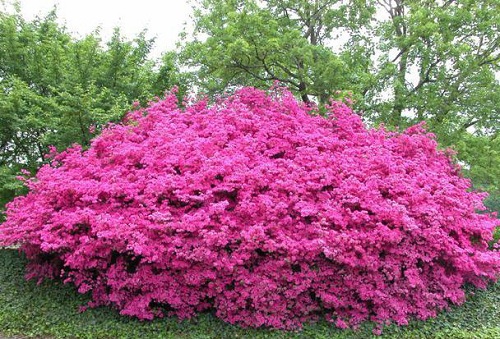
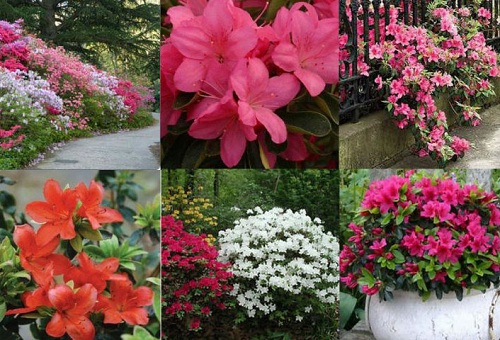
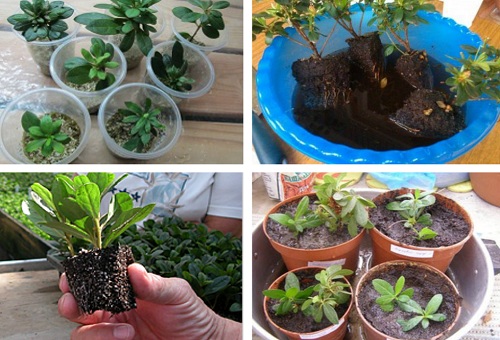
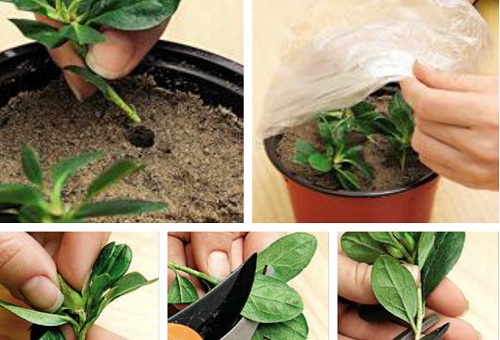

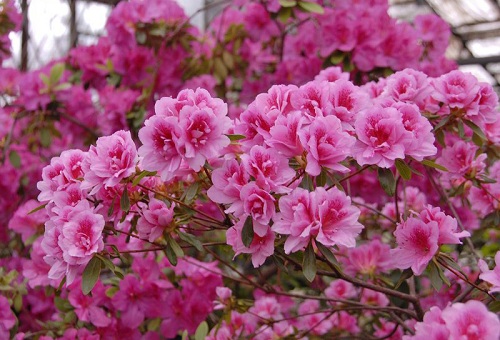
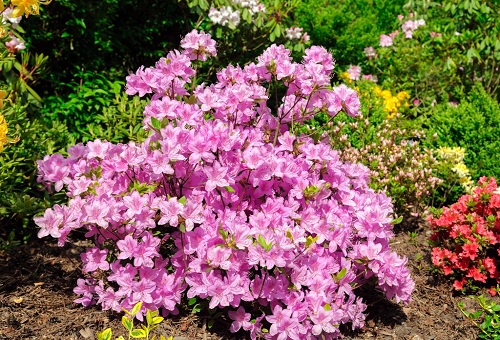
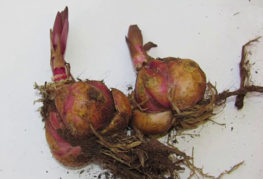
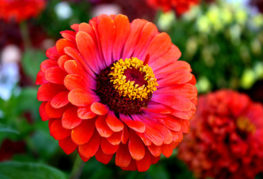
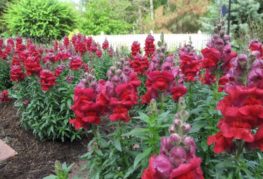
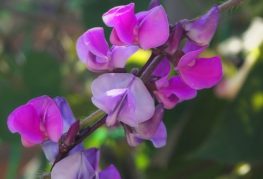
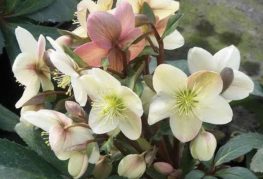
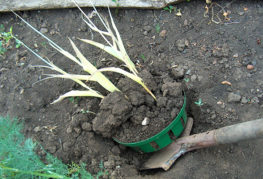
and will be published shortly.